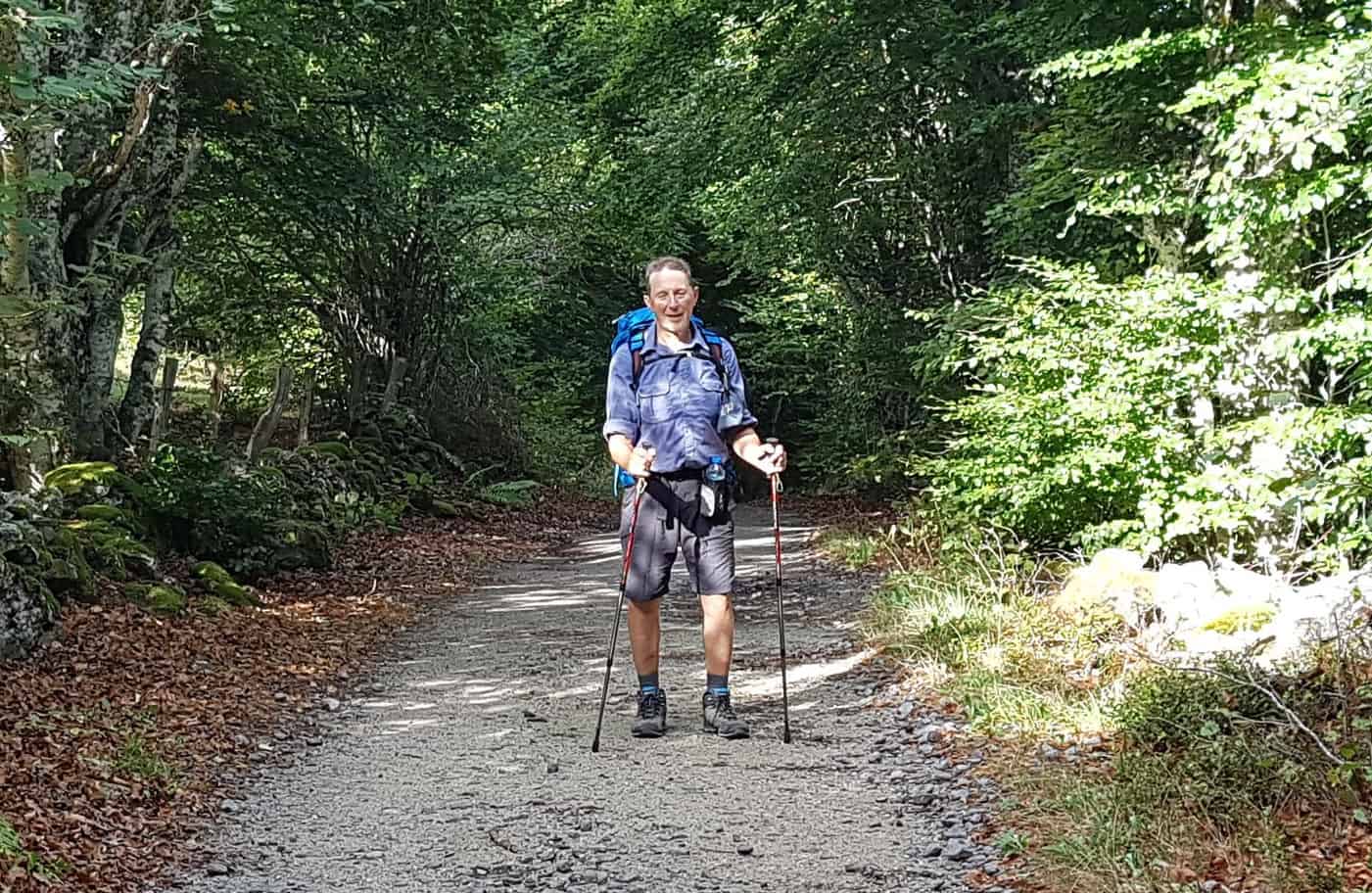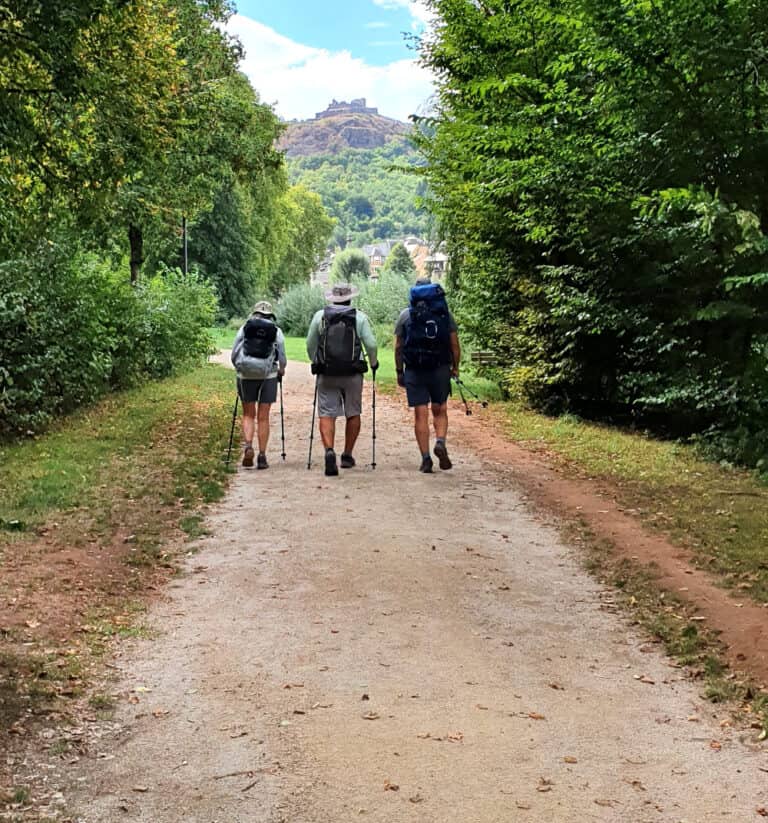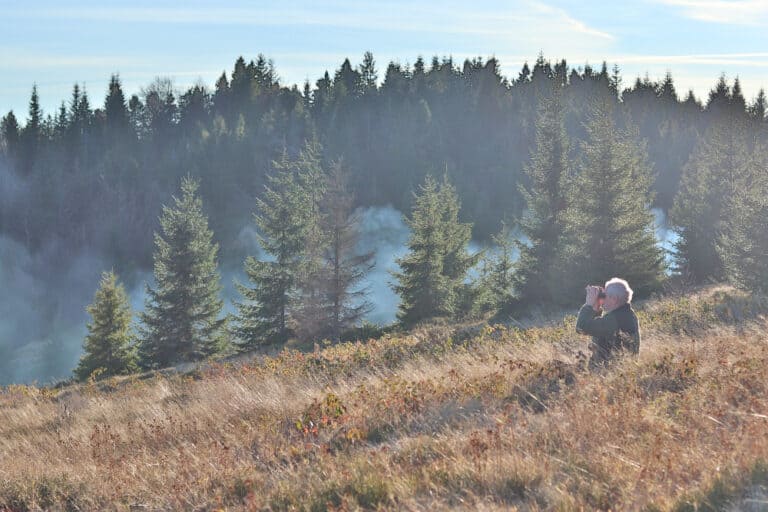How To Plan A Day Hiking Trip
Introduction
With this article on how to plan a day hiking trip I’ve drawn on many years hiking experience in quite a few countries, such as Ireland, United Kingdom, Portugal, France, Spain, Brazil and South Africa.
Hopefully I can add further to that experience and list in the years ahead. Some of the details around planning a hike may differ from country to country, but the solid principles and approach to planning remain the same.
I strongly recommend hiking as a most enjoyable and beneficial way to invest some of our time. But don’t forget, if you are beginning, or out of shape, build up slowly! As at the date of writing I’m age 70 and can still easily achieve 20km or more on day hikes, including maintaining that and more over multi-day hikes. I feel very fortunate that hiking has helped a lot to maintain good health and condition over the years. You could say living proof of the benefits of hiking!
I have found a useful way to cover the bases in terms of planning a hike is to ask the ‘Who, What, When, Where, How, and Why’ questions. We’ll look at those a little further down. So with that, let’s get into how to plan a day hiking trip.
Approach to Planning a Day Hike

Planning a great day hiking trip is about so much more than just a hiking equipment list such as footwear, backpack, clothing, food and water, various gadgets, etc.
There is a great deal we should be thinking about before we even get close to a list of stuff to wear or bring. We need to weigh up many considerations, and they vary, depending on the circumstances. On one extreme might be a few experienced hikers on a short, familiar trail. On the other might be less experienced or inexperienced hikers considering a challenging trail.
And having the intuitive judgment of knowing when and where to draw the line in terms of prudence and safety – perhaps the most important consideration of all.
Always worth bearing in mind: so many things, like politics, sales, also sports such as golf or tennis, look easy to the uninitiated. And so it is with hiking. Well, it’s just a walk, isn’t it, maybe a bit further than usual? Try it for real and it will show up weaknesses in our thinking quicker than we might have imagined.
Hiking scenarios are so diverse and limitless. For example consider the difference between, say, a hike in the Atlas Mountains, Morocco, and in The Everglades, Florida. Winter hikes, Summer hikes, Spring hikes, and so forth. It would be impossible to cover every single detail for planning a day hike in all scenarios. So let’s broaden it out into general categories, and look at an overview of important points within those categories. And ‘we’, could be the royal ‘we’, in other words just ourselves as a solo hiker, or it could be as part of a group.
Questions to Ask
A useful way to cover the bases is to ask the ‘Who, What, When, Where, How, and Why’ questions. They might look like this around how to plan a day hiking trip:
- Why are we going?
- When are we going?
- Who is going?
- Where are we going?
- What clothing do we wear?
- What equipment do we bring?
- How should we allow for the unexpected?
Questions like these guide us in looking at the important areas in terms of how to plan a day hike and carry it through to a success. The more experienced we are we may actually address some or most of them intuitively and subconsciously. But certainly questions like these are worth specific focus before we plan a day hike, especially if they touch on aspects of hiking that are less familiar to us.
Our Role In The Hiking Trip

We may be the organiser of the hike, or we may be invited along as a participant in a hike organised by others.
For solo hiking by ourselves clearly the hike planning is much simpler, as everything about the plan is under our control. Or, if we are organising a day hike for a group we have to consider each member of the group in relation to the overall hiking plan. Such things as the experience and ability of each member of the group, ensuring they are prepared properly and their equipment is adequate, etc.
If we are invited along on a hike as a member of a group the planning just involves our own preparation, but also an assessment of the hiking plan of the organiser. The kind of things to take into account would be the experience of and confidence in the organiser, the suitability of the route for the planned hike, the experience and preparedness of other group members, etc.
The Type of Hike
This will have a big overall effect on how we plan a day hiking trip, as there are so many circumstances and possibilities in relation to a hike. The plan could range from very modest low-level all the way to very adventurous and challenging. So clearly one plan will not fit all hikes.
- We could be just taking a relaxing stroll through established parklands or well-used and frequented easy local trails of modest distance. Not much planning would be required.
- Possibly a longer more arduous hike on a more challenging route for sight-seeing or fitness purposes. Research is needed to ensure the trail is suitable for the trip.
- A social hike with family, friends, etc. Adequate hiking ability for all participants, and suitability of the gear they are likely to have, is important.
- We could be leading a group of people on a particular hike. Ensure the hike is suitable for even the least experienced or able hiker in the group.
- Or to have a full day solo outing on a remote adventurous trail. Proper planning, preparation and taking account of the unexpected.
- And dozens of other possible types of hike
From the viewpoint of planning, we need to consider if the route for the hike is suitable, and the experience of the organiser or participants is in line with the demands of the trail.
The Season for the Hiking Trip
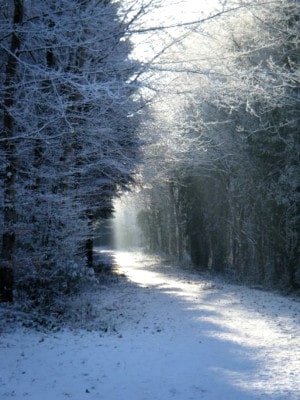
The season in which the day hiking trip will take place has an important influence on most of the planning aspects, including:
Each of these would be a significant topic in its own right, so we provide just an overview here.
Weather
The day to day weather conditions within each season also need to be taken into account in our planning.
As with the season, the expected weather on the day of the hike will influence all the planning aspects, including whether the hike should proceed or be postponed until the weather is more suitable. The most important consideration is that nobody’s safety should be put at risk.
Prolonged heavy rain or snow in the period before the hike may make certain sections or stream crossings dangerous or lead to other dangerous and unpredictable hazards such as avalanches. If in doubt, postpone the hike. Listen to the advice of experts.
Daylight Hours
Depending on the latitude of the location of the hike, daylight hours can vary enormously with the season. This needs to be taken into account when considering the distance of the hike and the likely time needed to complete it. A good margin of safety for daylight hours should be built in as a contingency for slower progress than planned, or unexpected incidents. It is normal for a hike to exceed the planned time unless on a route and with group members we’re familiar with.
Hiking Route Topography
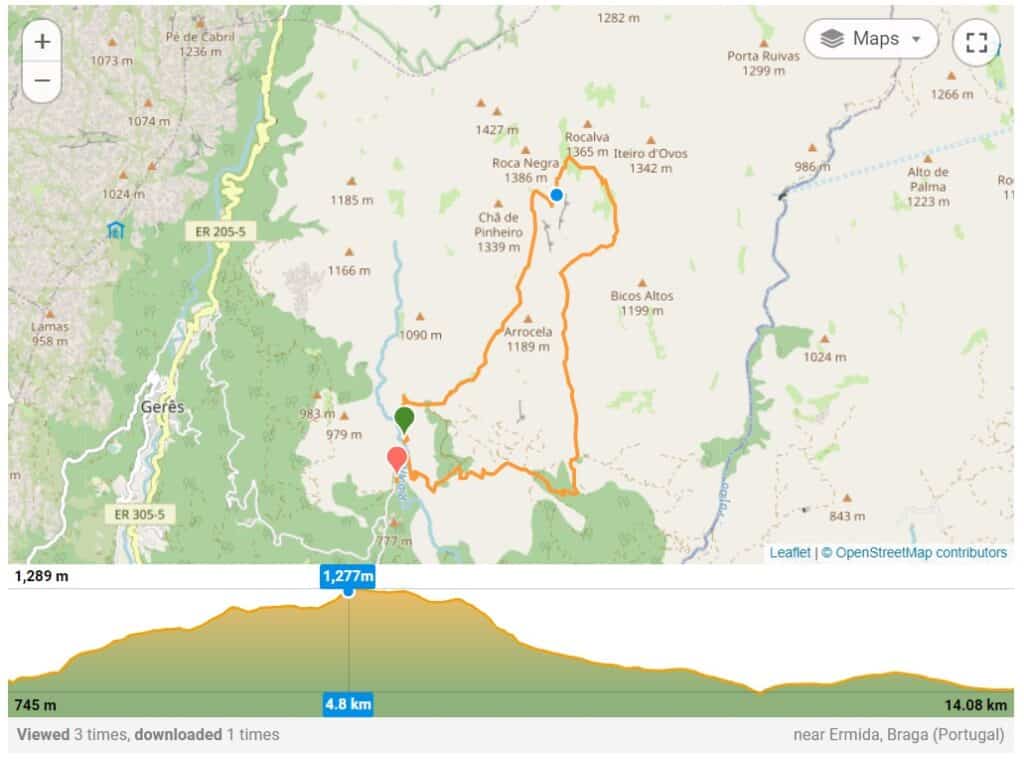
The topography of the hike route should be researched during the planning phase. It has a big influence on the ability and preparation of the hiker or hikers. The difficulty grading of a route can also change dramatically depending on the season and the weather conditions. These should all be taken into account in selecting a route for the hiking trip. Again, the safety of those taking part in the hike should be the primary consideration.
Solo or Group Hiking
This is a big thing and looks at important factors relating to the participants.
If we are hiking solo, or with one or more companions we know and hike with frequently, we are in a better position as to what to expect. Or if we are unfamiliar with the group or hike leader, we need to think a lot more carefully. For example, what is our relationship with the group and what our strategy might be if we are not sure about the leader’s apparent capability or plan. The leader needs to be able to demonstrate adequate experience for the planned hike. This could be through social media or other social proof channels. Do check their track record.
Decision on Group
I suggest we need to think about these things before taking part in the group hike, and make our decision on whether or not to participate at that point. If it is a low-level hike with minimal risk in relation to our own experience, no problem. Otherwise proceed with caution, and have a fall-back position, such as deciding at the hike start point not to proceed with the group on this particular occasion. There are no medals for heroics. Find a diplomatic excuse to bow out, but good sense should prevail. There will always be another opportunity.
Hike Leader Responsibilities
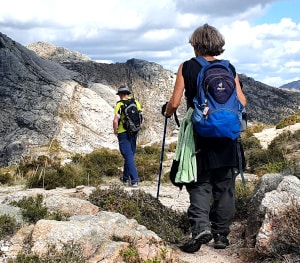
Check if there is an identified or implied leader of the hike. If yes, be aware of possible legal liability of the leader in some jurisdictions for the safety of each and every member of the group. Evaluate confidence in the experience and capability of the leader.
If we are the group leader, even an unconditional waiver of all liability and statement of responsibility by each member for their own safety may not be sufficient protection for the leader. Laws can be perverse but we are subject to them regardless. We need to do our liability research and make our decisions beforehand.
Individual Ability and Fitness
The level of fitness and resilience of each person going on the hike needs stack up in relation to the trail distance, the difficulty grading and the expected weather conditions.
Children and Pets on the Hiking Trip
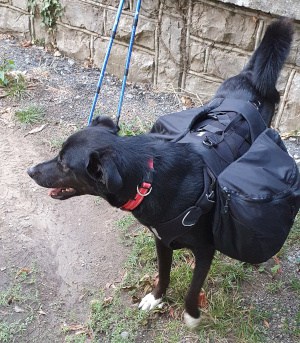
Children and pets on a hike are also something to bear in mind. My own view is that this is fine for a casual stroll or a very familiar low-level hike. My opinion is that any level of hiking beyond that is unsuitable for children or pets. Of course there may be exceptions. But I have also seen cases where parents and pet owners have made ill-judged decisions in this regard and it is at least disruptive for other group members. My suggestion is to put purely selfish considerations to one side in these circumstances. Ensure the hike is equally enjoyable for all group members. And if we are a leader of a hike, we must set appropriate rules and ensure everyone is aware of them prior to the hike.
One important point I’ve seen several times relates to pets. If a dog sees a wild animal, especially one making a dash for cover, the behaviour of the dog may become very unpredictable, regardless of its domestic temperament. Dogs should at least be on a good leash in these circumstances and I have seen several cases of major disruption due to dogs lost where they are off the leash and dashing away after wild animals.
Unexpected Incidents

We need to assess possible unexpected incidents and consider steps to mitigate them, in the light of their likely probability. Probably the most likely things that might happen are hikes taking longer than planned for various reasons, running out of drinking water due to trail distance, hot weather and exertion, and getting lost due to poor trail markings, navigation or inadequate maps. Amongst other things, blisters, minor injuries or even headaches and upset stomachs can also occur. So build some contingency for things like these into the plan. Especially, carry a small first aid kit including blister plasters, a pocket knife and maybe a small scissors.
Hiking Group Cohesiveness
A short note about group cohesiveness. If one is hiking with a hiking group, if possible carry out a quick ad-hoc assessment of personality types in the hiking group. The more cohesive the group, the more enjoyable and successful the hike is likely to be. Equally, good cohesiveness is a positive factor in the face of challenging trails and especially unexpected incidents. So the more dominant the number of team and consensus-orientated personality types the better for all!
The Hiking Route

Details of the route are needed, a good map or navigation app with trail details, distance, elevation gain and loss, difficulty grading, etc. If available, it is also very useful to know what the average speed over the distance is likely to be so that we can estimate the time required. Trail apps often provide this valuable data if others have done the hike and uploaded it to the app.
However, only use the trail data on the app as a guideline, not gospel. I have seen several cases of wildly inaccurate trail information on apps. Apply conservative real-world judgment and try to corroborate information with other sources.
We then need to build in time for rest, sightseeing and food stops to gauge total estimated time for the hike.
We could possibly call any information or tourist phone numbers beforehand to gather information about the trail, including if the trail is marked, etc.
The conservative suitability of the route for the people on the hike and their level of fitness, experience, preparation, etc. can then be made. Pay special attention to any streams, swampy ground, etc. that must be crossed as recent rainfall can have a significant impact.
Research the remoteness of the hike area in terms of proximity to villages, settlements, and the possibility of other people being on the route simultaneously. This offers an extra margin of safety in the event of unexpected incidents, for both our group and theirs.
When all information has been gathered and assessed we can confirm our estimate of required time to complete the route as planned, plus a contingency for any unexpected delays. It is also useful to confirm safe parking facilities at the startpoint of the hike. Likewise for the hike endpoint if it is not a circular route and pick-up has been arranged.
Route Reconnaissance
In terms of a group hike, prior trail reconnaissance by the hike leader is very worthwhile where a trail is unfamiliar. This was standard practice in some of my previous hiking and walking groups. It is a great idea in terms of confirming research, but not always possible.
Hiking Clothing and Equipment
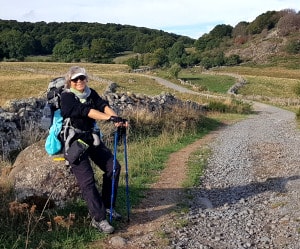
There is endless information online about every piece of hiking clothing and equipment, particularly from the actual vendors. Companies like REI in the US, Cotswold Outdoor in the UK, Bergfreunde in Germany, and hundreds of others provide specific details and advice on virtually anything you might require.
What hiking clothing do we wear?
We need to ensure the hiking clothing and footwear is adequate for the expected weather, in terms of temperatures, snow, rain, wind, etc.
Light coloured and lightweight fabrics are best for hot climates, and don’t forget long arm and leg protection from bush and bramble scratches if there is a lot of such vegetation on the route.
Layering is the best technique for cold temperatures. Don’t forget the gloves.
Except perhaps for short casual hiking outings, clothing and footwear should be geared specifically towards hiking. Pay special attention to footwear for protecting the feet and ankles on rough trails. Clothing should protect exposed skin, including the head, from excessive sun. Denim is not suitable for anything but the shortest outings, and trainers are only suitable for pavement. Footwear with good ankle support is very important on rougher trails.
What equipment do we carry?
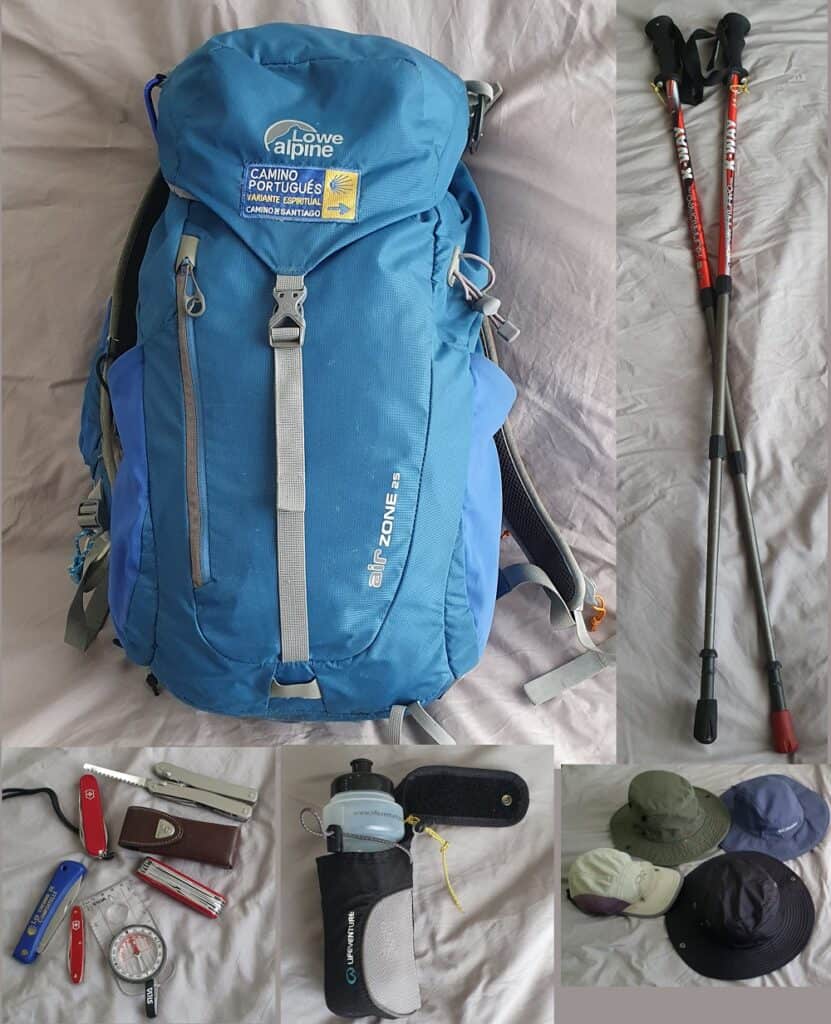
Again, many sources of what to pack for a day hike are available online. For example there is a good hiking packing list here. Hence this article is just an overview of the important pieces of equipment.
The best policy is to buy quality gear from a reputable source with a proven track record in outdoor equipment. It may be more expensive initially, but the pay-off is we can have more confidence that the equipment will be fully fit for purpose. And generally the cost of ownership of quality equipment is lower over the long term and has better functionality than initially cheap equipment.
These are the important things on my hiking check list:
- Small first aid kit including blister plasters and small supply of pain killers
- Backpack or rucksack. I use a 25lt Lowe Alpine backpack for day hiking, and it is perfect!
- Walking poles. For me these are an undervalued and underused piece of equipment. I never go hiking without mine.
- Hat, sunglasses and sunscreen. Vital for hiking in bright sunny climates.
- Smartphone with trail app, spare battery and connecting cable. The trail apps for the areas I hike are Wikiloc and Outdooractive (previously ViewRanger). Ensure the phone and spare battery are fully charged.
- Map and compass. Good backup even if you have a trail app.
- Pocket knife. You never know when it might be needed. Many have several handy features.
- Headlight or torch. In the event you get caught out in fading daylight.
- Medication. As necessary.
- Wallet and credit cards. Part of any normal life.
- Food and water. Most important is enough water plus a safety margin.
- Small plastic trowel for sanitation purposes
Be environmentally aware, thoughtful and considerate of others on the trail. Ensure we bury any human waste we generate and wipes we use, or take them off the trail with us in plastic bags. Leave no trace.
Day Hiking – Allow for the unexpected

The most frequent scenario for things going awry on a day hiking trip would be taking longer than planned to complete the day hike. This can happen especially with a group and during short winter days. Simply build contingency into the planning. And bring some head torches just in case.
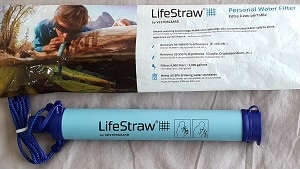
Running out of drinking water is another ever-green, normally due to weather being hot. How we get around this may vary. Mountain water may be fine in many places. But in others, especially where there is a high population of sheep and wild animals, it is definitely not recommended. This is due to possible contamination of streams, etc. with dangerous bacteria from faeces or dead animals, etc. A possible solution is also carrying a good water filter capable of removing dangerous bacteria. I have a LifeStraw water filter for this purpose.
Another possibility is getting lost. The first layer is a smartphone with an app that shows the trail we intend walking and alerts us is we wander off course. This implies GPS coverage, but most places on earth are now covered. Next is a map of the route and a compass. Third is an awareness of our orientation in relation to the start of the hike through landmarks, rivers and expected sun position. Also appropriate to make inquiries at any local information or tourist offices if there is anything special we need to be aware of while doing the hike. And if possible, notify somebody home-based about our intended route and expected return time.
These are just some of the possible unexpected events.
How To Plan a Day Hiking Trip – Conclusion

Hiking is such a beneficial and rewarding activity, but it does require some mindful planning and preparation to be consistently successful in getting the best from it.
Thinking about who is going, researching the trail and using the right footwear, clothing and equipment are very important. A prepared day hike checklist is very useful. This can make all the difference to your safety, comfort level, and overall experience on the trail.
In addition to having essential items we have indicated above, you should also be prepared for the possibility of unexpected occurrences such as taking longer than expected or running out of drinking water. And if in a group maybe emphasise the importance of group cohesiveness to ensuring that unexpected events are taken in stride.
When venturing into unknown areas it would be good practice to check local information offices regarding any special considerations needed while hiking. Take heed of their advice.
Finally let someone know where you will be so they are aware of when to expect you back home – this may not always possible but it is also good practice if at all feasible!
With these tips on how to plan a day hiking trip in mind we hope that you have safe and enjoyable hikes in the great outdoors!

